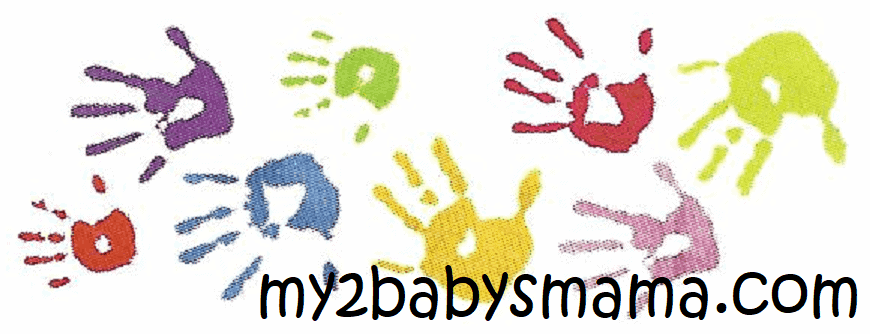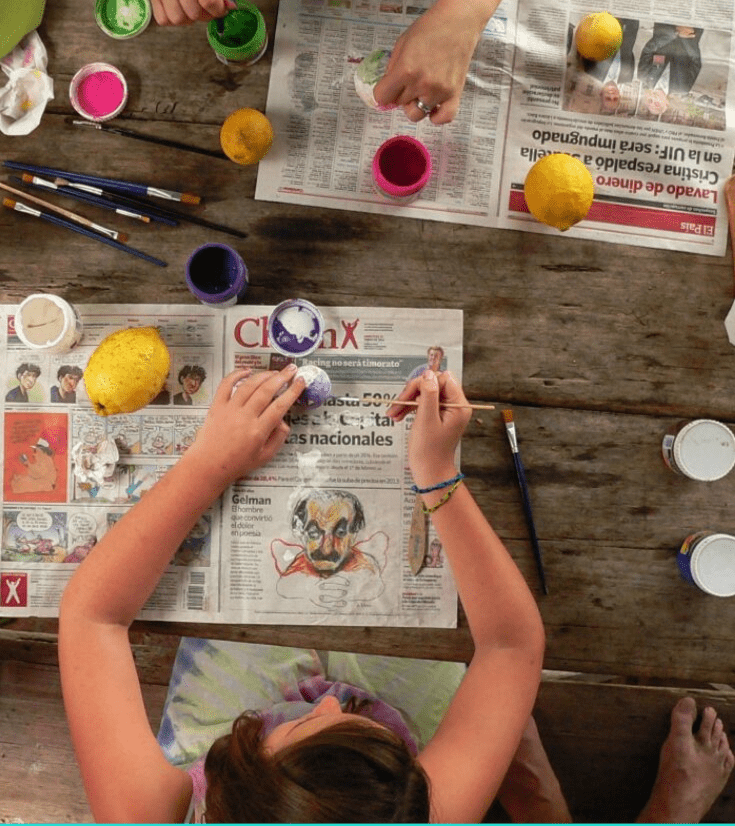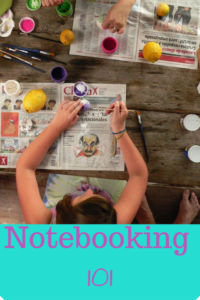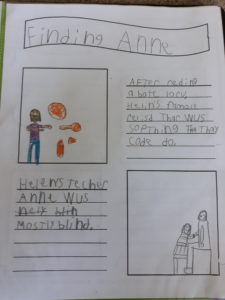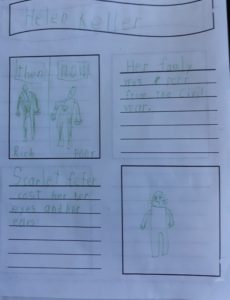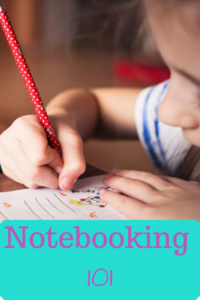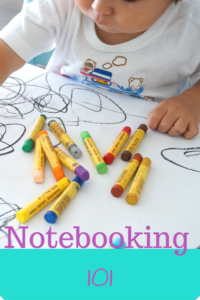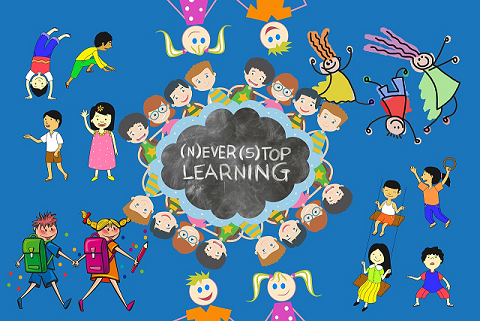Notebooking 101
When I first embraced the Charlotte Mason approach to teaching my children, I found notebooking as a way to bypass all those endless worksheets. I have extensive experience with worksheets, both as a student and as a teacher. When I taught using the ABeka curriculum, I found it to be worksheet heavy, which created a lot of busywork for both my students and for myself. I also knew that all those worksheets were not helping my students learn how to deal with the lessons in real life. They could fill in the worksheets correctly, but when it came to using the information they struggled.
So when I read about notebooking I was thrilled. Using notebooks, my children could practice what they learn and it would give them a way to make a keepsake that they could look back on as adults.
“A Blank Page”
According to Laurie Bestvater in her book, The Living Page, real Charlotte Mason notebooking begins with …”a blank page.” But blank pages scare me, because while I went to school I was always commanded to “fill up as much of that white space as possible.” I had no idea what to fill the white space with, and no idea how to tell my kids what to do.
Even though blank pages scared me, I jumped into notebooking with both feet. I researched as much as I could, found a notebooking website with lots of wonderful notebooking pages, and devoured everything that I could read about what Charlotte Mason said about notebooking. I wanted to do this thing correctly.
One of the first things I did was to set up my Book of Centuries that I received as a freebie from simplycharlottemason.com. Several notebooking websites had free notebooking printables which I used a lot of paper to copy. My imagination ran wild with pictures of how my children would just love notebooking and how they would learn so much.
-
My imagination did not match reality
Once again, enter real life. I had no idea how to implement the ideas. We would read about a particular historical figure and then I would find a picture of that person online, print it out, and glue it into our book of centuries. It worked for awhile, but the kids didn’t care and it became a lot of work for me, especially if we were reading about more than one person per day. Then I decided to take it out of the book and put the entire 6000 years of world history on our wall.
That just created a different mess. The paper kept falling off the wall. It was a lot of work for not much learning, so I finally gave up. I decided that I would drop any notebooking as a requirement for my kids and just keep notebooks for them. That meant that every month I would print out the journal of notes that I took of our daily work, and place any work that the kids did in a 3 ring binder.
Don’t give up!
But I have not lost my desire to use notebooks in my homeschool. I still researched notebooking from time to time until I found this blog post by Danika Cooley. She took the act of notebooking and broke it down into parts that I could understand.
This summer is the perfect time to start notebooking We use a light schedule, being more laid back. When I tried to implement notebooking before, I attacked full on and the kids and I both experienced confusion and overwhelm. I tried to use notebooking in every subject every day, and it became too much. So this time I determined that I would take it slowly.
-
Start slowly
Notebooking is a completely different way of recording what has been learned. You don’t fill in the blank or choose from a multiple choice grid. Each child takes what he/she has learned and interprets it, putting it down on paper in his/her own way. It takes a great deal of time to learn how to notebook. There is never just one right answer. My biggest mistake when I started with notebooking was starting out with all subjects at the same time. My kids were overwhelmed, and instead of it being fun, it turned into torture.
This summer we are concentrating on Bible, history, science, and writing. We are notebooking in each subject, but we are starting off small.
Bible
In Bible we read the Bible passage together. As we read we stop, narrate, and discuss what we read. After we feel our discussion concludes satisfactorily, then the kids write one or two sentences to summarize what we read. Bear Bear loves to draw so she usually draws a picture to accompany her sentence. Super Stuffy usually draws stick figures, but that’s ok!. I have learned that it’s not about the beauty of the notebook, it’s about what my kids are learning.
History
For history we started reading Helen Keller. We read from that book every other school day. I took one of the beautiful notebook pages that I had printed out a long time ago and copied it for each day. This particular page contains two boxes for pictures and two sections for sentence writing. I read one chapter per session, and we stop somewhere in the middle of the chapter to discuss and the kids write one sentence to summarize the portion that we have read. Just one sentence! Start out small! My kids hate to write, but because I only require one sentence, they almost have fun with it!
Science
On opposite days we work through science. I allowed the kids to choose living science books that interested them. Super Stuffy is currently studying dinosaurs, and Bear Bear is studying underwater animals. We read the books together, and they both write one sentence to summarize what they have learned and draw a picture or a diagram to go with it.
-
Lower your expectations
When I first started notebooking Bear Bear and Super Stuffy were several years younger. I expected too much of them. I thought that they would be able to verbally narrate what we had read, and then translate that into their writing. All that did was create frustration in all of us. I was disappointed because they didn’t know what to do. They were doubly frustrated because they couldn’t figure out what they were supposed to do, and they knew that I was disappointed.
Don’t expect grade level work at first
Even though both of my kids read proficiently, for the time being I do not require that they read on their own. Right now we just practice narrating and writing together. As a mom and a teacher, I forget so easily the hard work involved in processing through narration and then being able to write down what I am thinking. By taking away the reading requirement, I am allowing them to focus on learning the writing process. Once they become more comfortable with notebooking I can slowly increase my expectations.
Let go of correct grammar and spelling for now
Another big mistake of mine when I first started notebooking was requiring proper spelling and grammar right away. I figured that allowing them to misspell words as they wrote would teach them bad habits, so I insisted that they write correctly. But for my kids, having to stop to figure out how to spell a word stifled their ability to get their ideas down on the paper. So I let go of the editing for awhile. Don’t be scared to let it go. They will learn how to spell and use correct grammar. Because they are novices right now, I allow them to focus on just getting their thoughts down on paper.
Provide the guidelines for what you want included in their notebook entry, but leave the content up to them.
Notebooking may start with a blank page, but that doesn’t mean that there aren’t some guidelines. At the beginning I started by swinging from one side of the pendulum to the other side. At first I asked the kids to use the notebook page just like a blank worksheet. “Fill in these answers; demonstrate this particular fact; etc. ” Then I swung to the other side and left it completely up to them. They could fill in their notebook page with anything that they wished, even if it didn’t demonstrate the topic at hand.
This is how we notebook:
- I bought 1 1/2 inch D-ring 3 ring binders for each child. I then used dividers to create sections for each subject.
- The kids sit down with their pencils, crayons and notebooks open to the appropriate section and listen as I read.
- I read one section at a time. We discuss the passage and the kids narrate what they have heard.
- Then the kids take turns giving examples of sentences that they can write, and then they write them down.
- If the kids have difficulty with narrating or coming up with something to write, then I coach them on what to write. They write their sentences, and then I read the next section.
- When we are finished for the day, they are responsible for putting their notebook page in a page protector and inserting it into their three ring binder.
Now, the majority of our schoolwork consists of notebooking, and I have already seen progress in the kids’ narrating and writing abilities. Just the other day, Bear Bear was able to use her previous notebook page to remember what we have already covered.
I felt a moment of elation. This type of notebooking is working! And, at the end of the year, those notebooks will be more of a keepsake to my kids, just because they created them.
Are you like me? Have you struggled to figure out how to have success in notebooking? For this list making mama, it at once seemed so simple and yet so complicated. I hope that this post can make it at least a little bit clearer. If you have had trouble with notebooking in the past, my biggest piece of advice is to not give up. Keep trying, and maybe one of these tips can help you.
